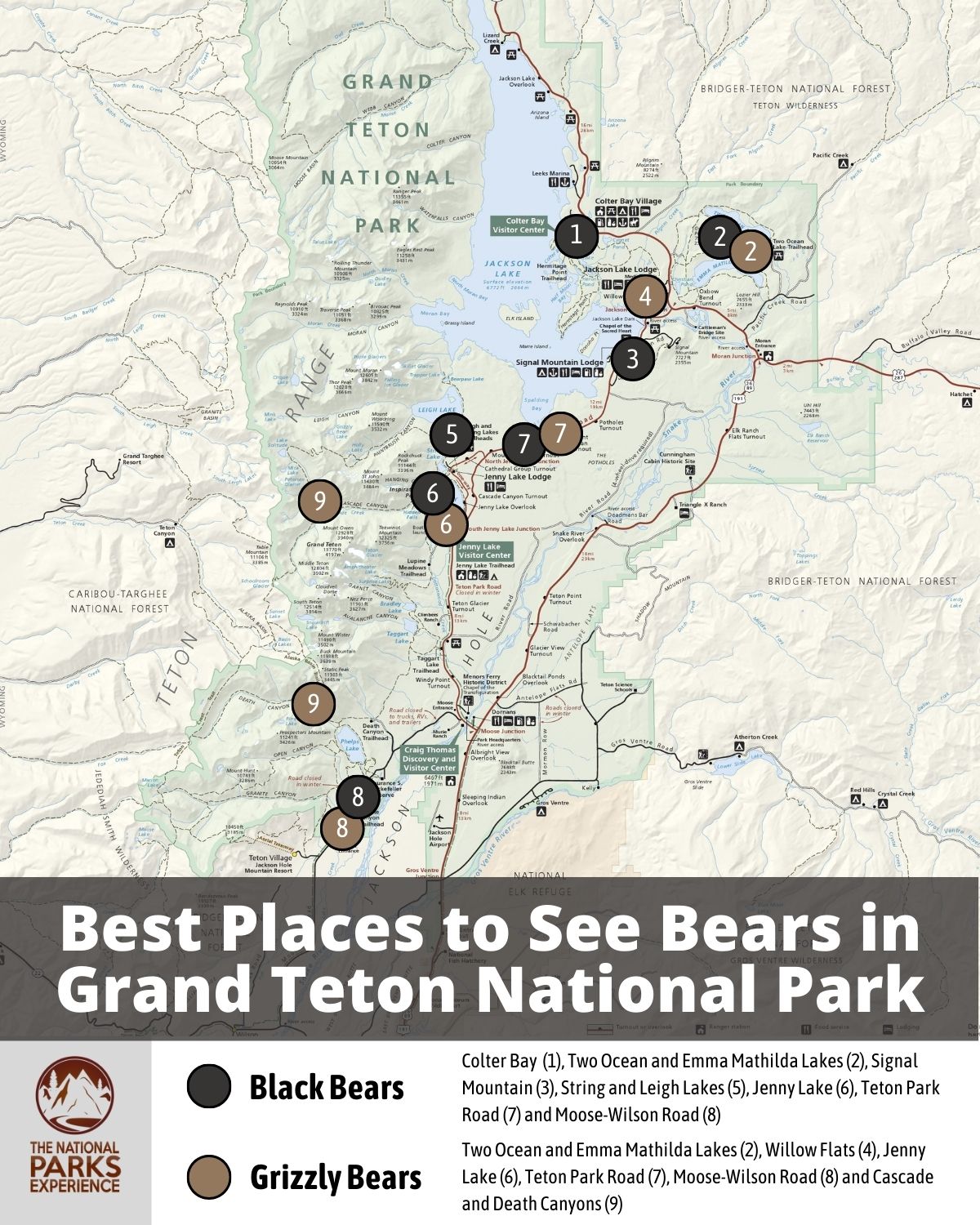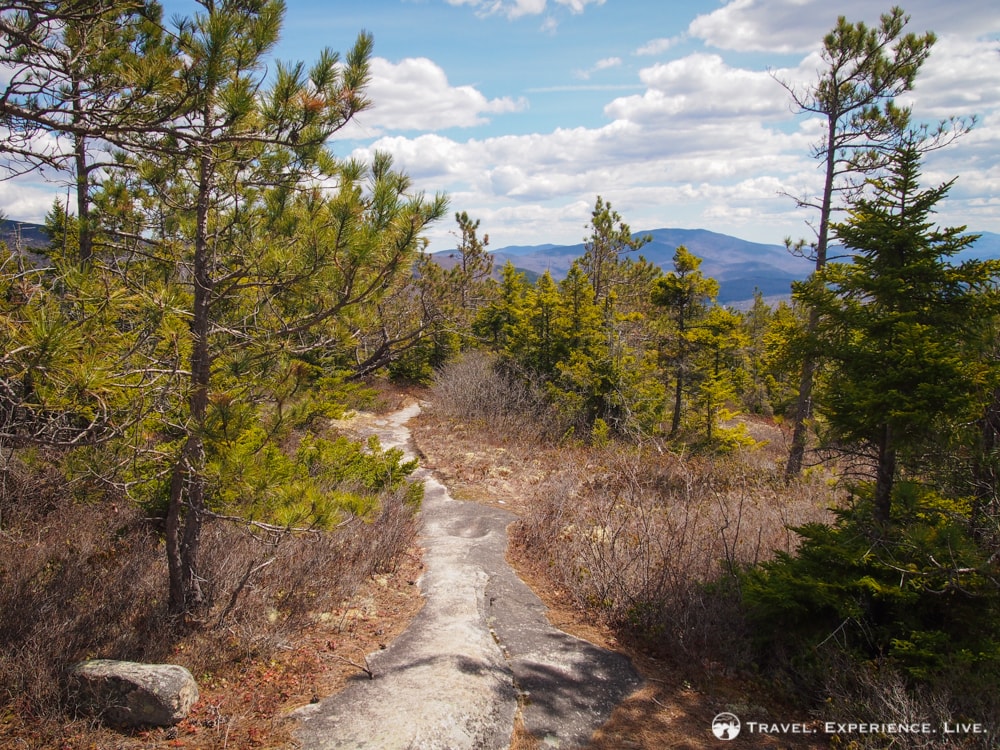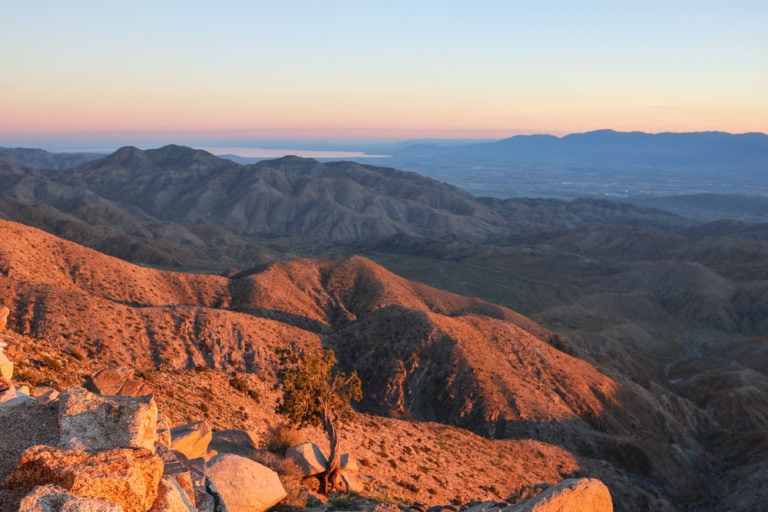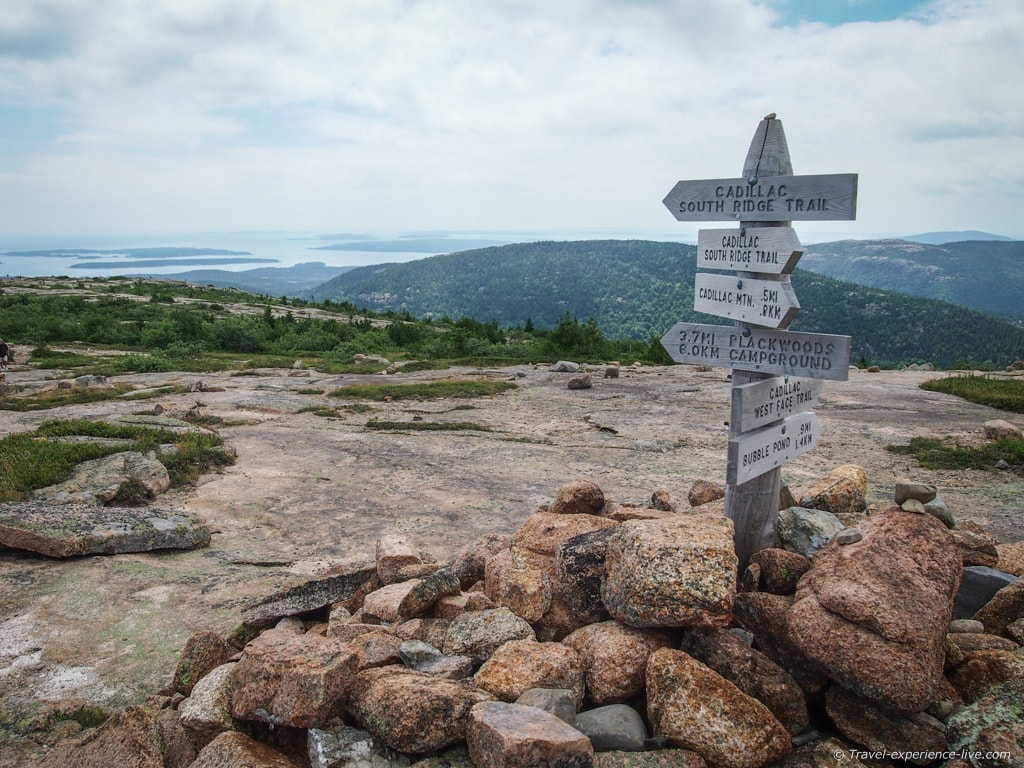Where to See Bears in Grand Teton National Park
The sagebrush flats, ponds, streams, and mountains of Grand Teton National Park are prime bear habitat. Both black and grizzly bears call Grand Teton home, thriving in the park’s varied ecosystems and present in virtually all areas.
Some parts of the park, however, are simply better than others to view these magnificent animals in the wild.
“Wild” being an important word here—the bears of Grand Teton National Park demand respect and caution, and can occasionally be aggressive. More on that below.
Seeing black bears or grizzly bears in Grand Teton is one of the highlights of any visit to the park. This is, after all, one of only a few national parks in the contiguous United States where both bears species live.
So, if you’re planning a visit to the park and would like to see some bears, you’ll find the best bear viewing areas in Grand Teton below.
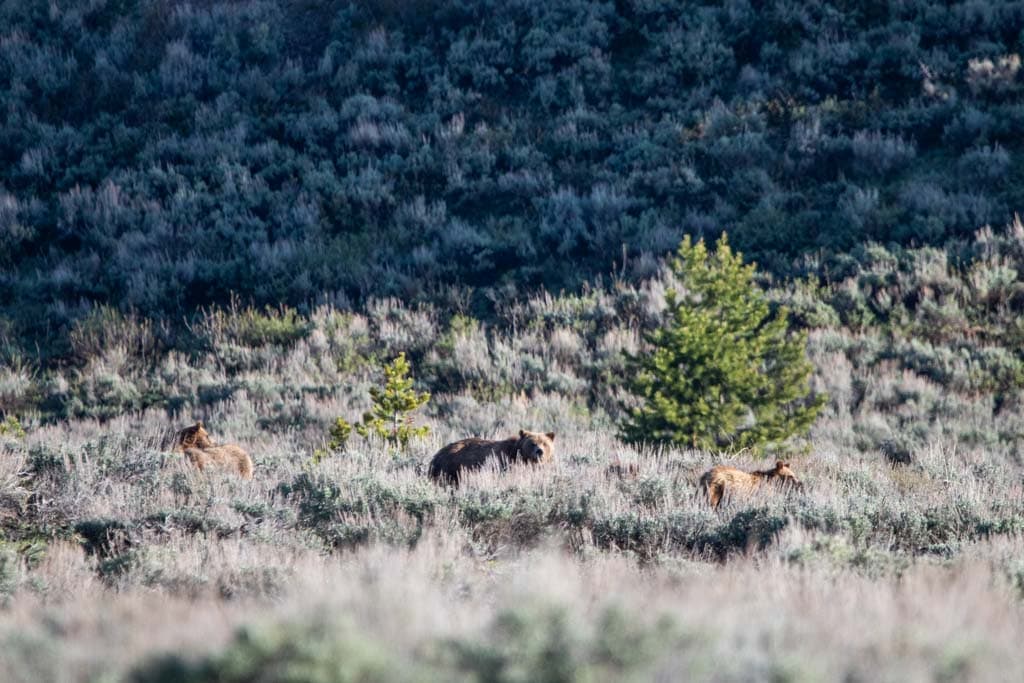
This blog post about the best places to see bears in Grand Teton National Park contains affiliate links. You can read more about our Terms of Use / Disclosure here.
What Are the Differences Between Black Bears and Grizzly Bears?
When watching bears in Grand Teton, you’d probably want to know which bear you’re looking at!
While there are a number of significant differences between black bears and grizzlies, it can sometimes be challenging to figure out what species it is from a distance.
The following information should help you determine whether you’re observing a black or grizzly bear in Grand Teton National Park.
How to Recognize Black Bears
The American black bear (Ursus americanus) lives all over the United States and Canada.
It is the smallest of the three bear species found in North America—the polar bear is the third North American bear and by far the largest. Extremely adaptable, black bears are present all over the country, in at least 40 states.
You can recognize a black bear by its straight face profile, small claws, large protruding ears, and lack of shoulder hump.
Although they’re called “black”, black bears can actually be black, but also dark brown, brown, blue-ish black, and cinnamon. Because of this, they’re occasionally confused for grizzlies.
Even if the animal is a lighter brown color, its long ears and the absence of a shoulder hump should confirm it’s a black bear.
Black bears are very common throughout Grand Teton National Park.
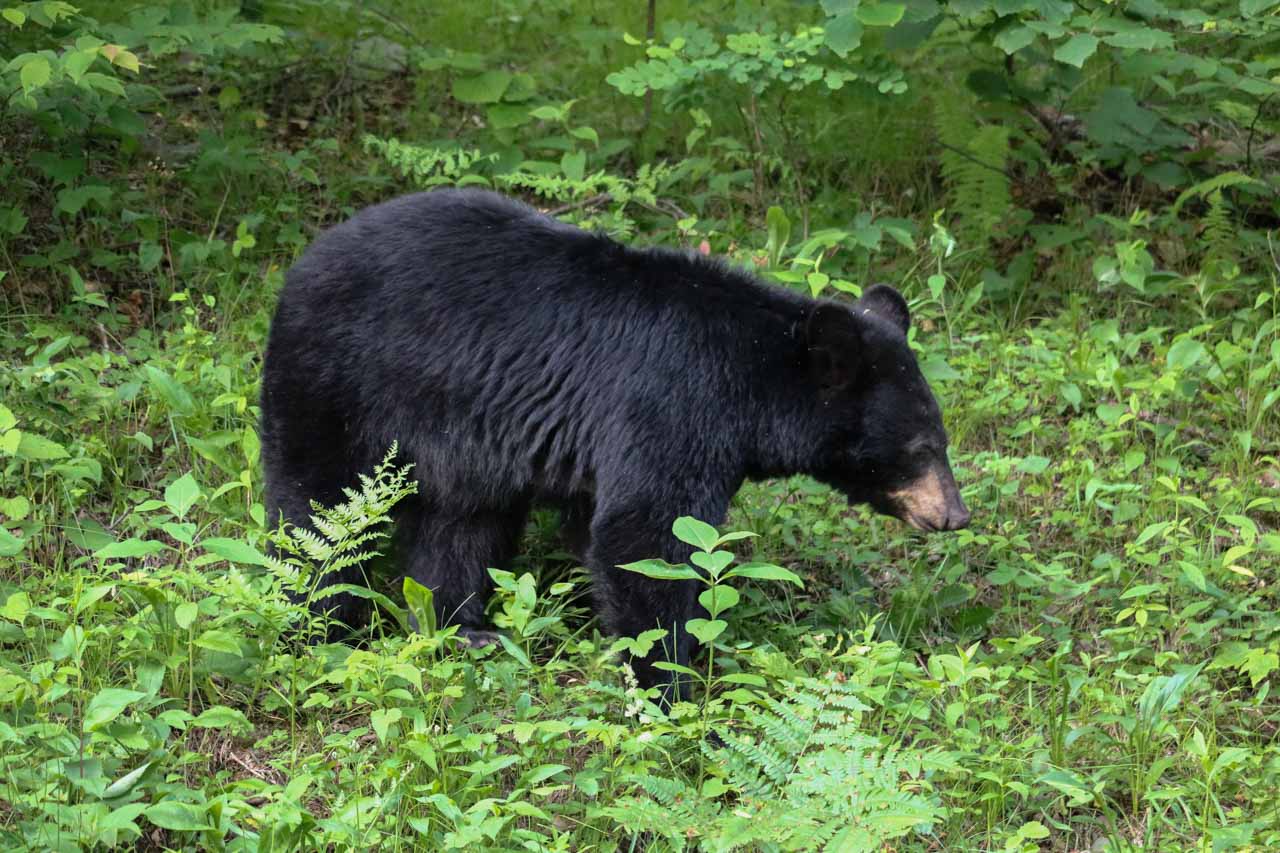
Note: There’s not a whole lot of information available specifically about the bears of Grand Teton National Park. Most research is done on the bears in adjacent Yellowstone National Park or in the Greater Yellowstone Ecosystem (GYE) as a whole, of which Grand Teton is a part.
Many of the numbers and statistics below are based on research done in those areas, rather than specifically in Grand Teton National Park itself. They are, however, a good indication of the behavior and habits of the Grand Teton bears (many of which regularly wander from one park to the other).
Fun Facts About Black Bears in the Yellowstone-Grand Teton Region
- American black bears are the only bear species endemic to North America. They aren’t found in the wild on other continents.
- Black bears can climb trees very well.
- Their preferred habitats include dense forests, river basins, and woodland edges.
- Black bears are omnivores. Their diet consists of various foods, from elk calves, rodents, cutthroat trout and insects to grasses, pine nuts, fruit, berries and other plant materials.
- Male black bears weigh 210-315 pounds, while female black bears weigh 135-200 pounds.
- Adult black bears are about 3 feet high at the shoulder.
- Black bears can grow 15-30 years old.
- Black bears have a superb sense of smell and can see colors.
- Female black bears don’t tend to attack humans to protect their cubs. Their instinctive reflex is usually to run away or climb a tree.
- Black bear attacks are extremely rare (when they do occur, they’re often predatory).
- There has never been a confirmed fatal black bear attack in Yellowstone National Park, nor in Grand Teton National Park.
How to Recognize Grizzly Bears
A subspecies of the brown bear, grizzly bears (Ursus arctos horribilis) are among the most-feared animals in America. This reputation of vicious, mauling predator is unjustified, though.
Yes, they may be huge and imposing, powerful enough to cause major injuries to any other animal, including humans, but they can also be gentle and curious.
Grizzly bears are, on average, much larger than black bears. According to the National Park Service, they’re “generally 1.5 to 2 times larger than black bears of the same sex and age class within the same geographic region.”
The most distinguishing body features of grizzlies are their large claws and clearly visible shoulder hump. Both these characteristics help grizzlies dig for food.
Additionally, grizzly bears have short, rounded ears and a so-called “dished” face profile, with a nose that somewhat sticks out from their face.
While they used to live all over North America, their range is now limited to Alaska, Canada and a few of the lower 48 states.
There are merely 1,500 grizzlies left in the lower 48 states, 800 of which live in northwest Montana. Another 700 or so call Wyoming’s Yellowstone-Grand Teton area home, arguably the best national parks for wildlife watching, while Idaho has about 100 grizzly bears.
Currently, there are approximately 700 grizzly bears in the Greater Yellowstone Ecosystem (GYE), which encompasses both Yellowstone and Grand Teton National Parks.
Many of those grizzlies live within Grand Teton National Park permanently or wander through the park.
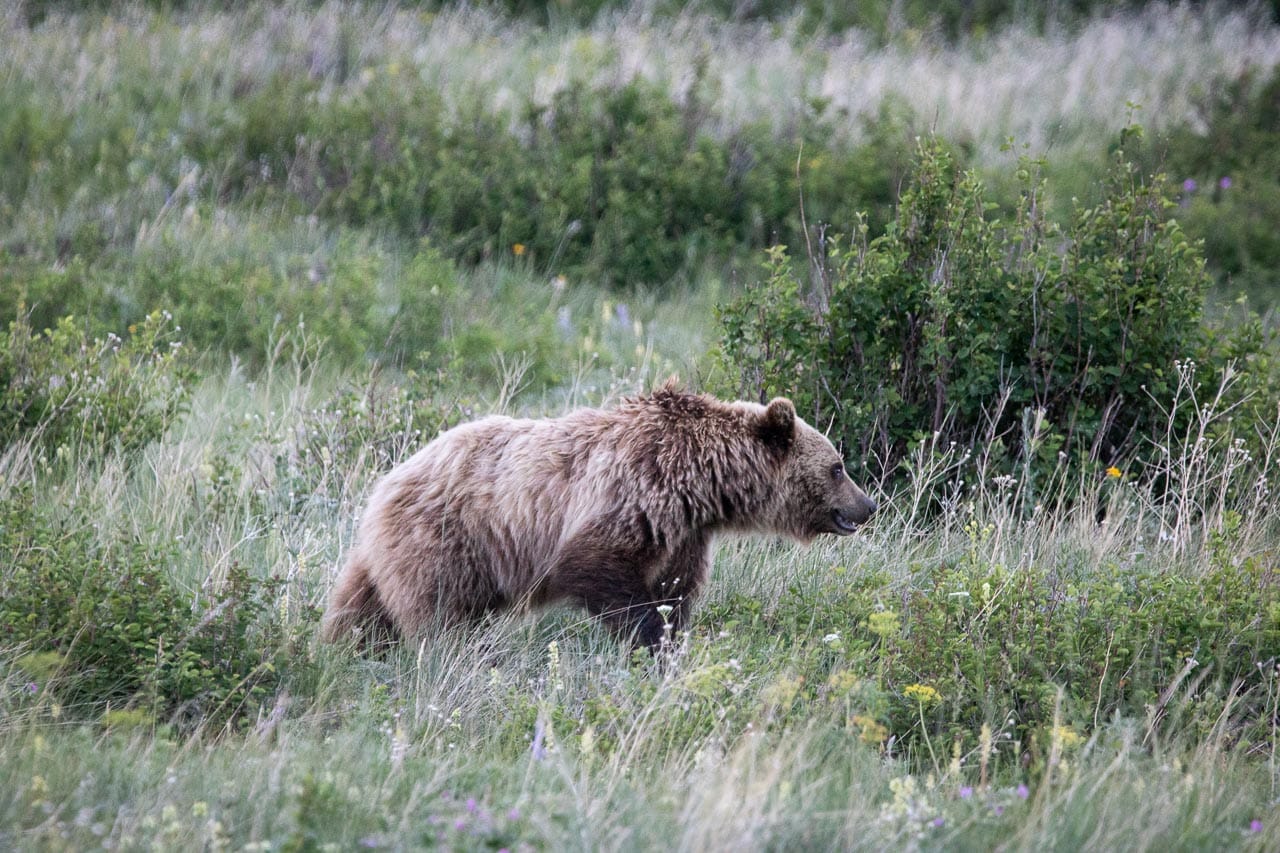
Fun Facts About Grizzly Bears in the Yellowstone-Grand Teton Region
- Grizzlies are a subspecies of the brown bear. Grizzly bears are brown bears that don’t have access to food sources from the ocean. In coastal Alaska, Europe and Asia, they are known simply as brown bears.
- Young grizzly bears are able to climb trees. However, their weight and curved claws make this increasingly difficult as they get older.
- Grizzlies live in forests and are usually seen in and near meadows, clearings in the woods, and open plains. In summer, they also move up to the park’s barren slopes and mountains.
- Grizzly bears are omnivores. They eat a wide variety of things, including the calves of elk, deer and bison, cutthroat trout, other (smaller) adult mammals, insects, carrion, roots, nuts, berries, grasses and other vegetation.
- Male grizzlies weigh 200-700 pounds, while female grizzlies weigh 200-400 pounds.
- Grizzly bears are about 3.5 feet high at the shoulder.
- Grizzly bears can grow 15-30 years old.
- Grizzlies are exceptionally agile and can sprint up to 40 mph, which is faster than a regular horse.
- Female grizzlies are notorious for aggressively defending their young against threats. The majority of grizzly attacks are defensive attack by sows with cubs.
- Grizzly bear attacks are very uncommon (when they do occur, they’re often defensive to protect cubs or a food source).
- Since Yellowstone National Park’s establishment in 1872, only 8 people have been killed by bears in the park. Seven of those fatalities were caused by grizzlies, while one was unconfirmed. This is out of an all-time visitation total of more than 195 million recreational visits (up to and including 2021).
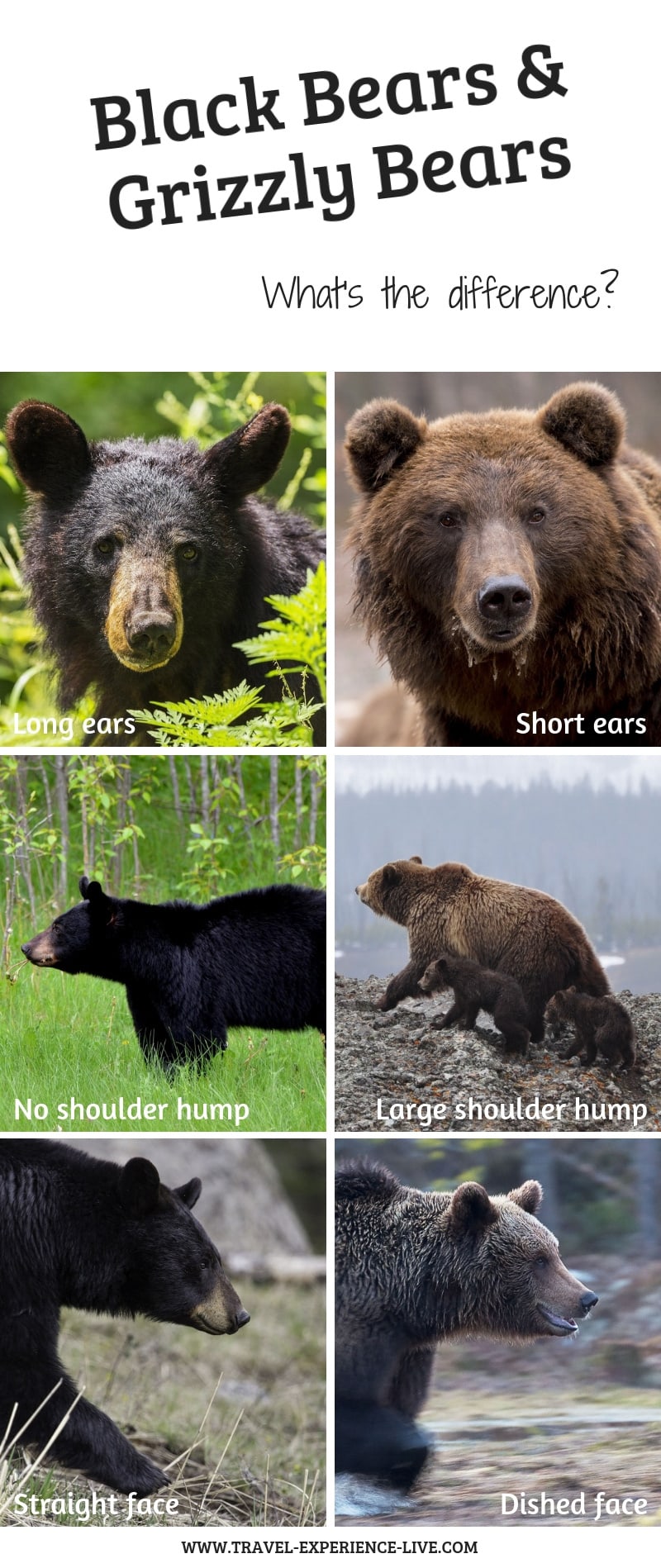
Best Places to See Bears in Grand Teton National Park
While it’s possible to encounter a bear throughout Grand Teton National Park, they do seem to enjoy hanging out in certain areas better than others.
As I talked about above, black bears prefer forests and areas with denser vegetation. Grizzlies, on the other hand, like open spaces, such as barren slopes, meadows, sagebrush flats, and forest clearings.
These are generalizations, though. It’s possible to see either one of them anywhere in the park. Moreover, several areas in Grand Teton boast ideal habitats for both bear species and, therefore, offer amazing opportunities to see black and grizzly bears alike.
That all being said, let’s take a look at the best places to see black bears and grizzly bears in Grand Teton National Park.
Where to See Black Bears in Grand Teton National Park
The black bears of Grand Teton are most common in the park’s central area, essentially all throughout the woodlands and patches of forests along the Teton Park Road.
This portion of the park features numerous ponds, dense forests, rocky terrain, as well as open areas. It is prime black bear habitat, providing the animals with a plethora of food sources and shelter.
Colter Bay
Located on the eastern shore of Jackson Lake, Colter Bay is a popular tourist area in the north of Grand Teton National Park.
Numerous amenities and services are available here, including lodging, camping, restaurants, shops, a gas station, the Colter Bay Visitor Center, a boat launch, and a number of nice hiking trails.
While exploring the Colter Bay area, it’s not unusual to catch a glimpse of a black bear foraging in the woods.
Great hiking trails to see black bears, as well as other wildlife like moose, elk, and birds, are the Lakeshore Trail, Swan Lake and Heron Pond Loop, and the superb Hermitage Point Trail.
Two Ocean and Emma Mathilda Lakes
Black bears frequent the lush vegetation around both Two Ocean Lake and Emma Mathilda Lake, situated in the northeast corner of the park.
Two Ocean Lake is accessible by car and has a lakeshore picnic area and trailhead. Emma Mathilda Lake, on the other hand, is reachable only on foot.
You can hike around each lake in individual hikes, or combine both lakes in an extended loop. Note that these day hikes are rather long day hikes, though, and take you into pretty remote wilderness areas.
- Two Ocean Lake Loop: 6.4 miles total, 3-4 hours
- Emma Mathilda Lake Loop: 10.7 miles total, 5-6 hours
- Two Ocean Lake – Emma Mathilda Lakes Loop: 13.2 total, 7-8 hours
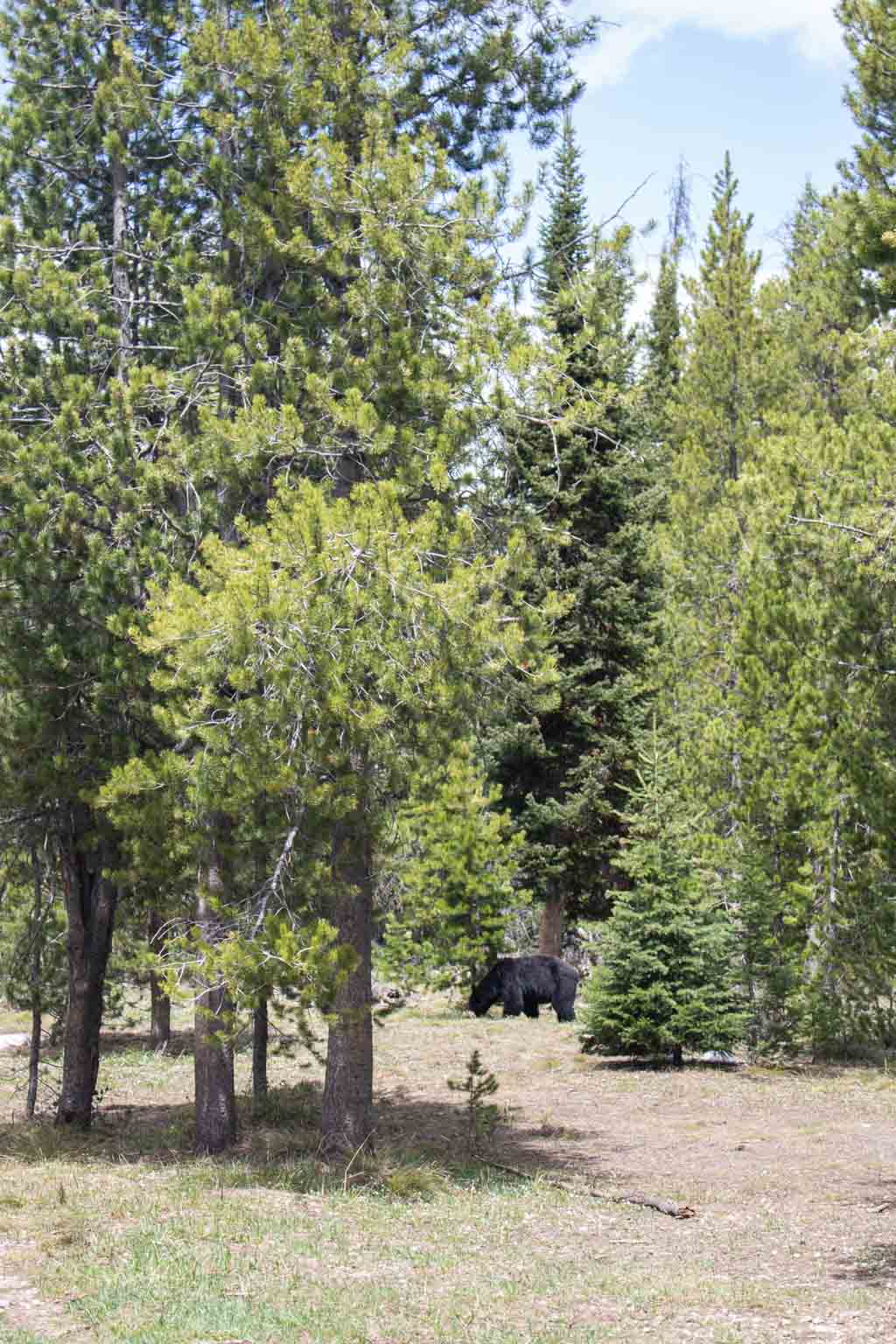
Signal Mountain
One of the busiest areas in Grand Teton National Park, Signal Mountain sits on the southeast shore of Jackson Lake.
This is where you’ll find the Signal Mountain Lodge, campground, a gas station, restaurant and bar, camp store, a marina and boat launch, and guided activities.
Signal Mountain is also popular among the park’s large wildlife, including black bears, elk, and moose. Grizzly bears are occasionally also seen in this area.
“Bears are often seen on trails and in developed areas” at Signal Mountain, the National Park Service says. So, be aware of your surroundings, even in parking lots or near the cabins.
Additionally, this is also the start of the wonderful Signal Mountain Trail, a 6.8-mile roundtrip hike to the summit of Signal Mountain, which offers spectacular views of the Teton Range. On the way up (and down), look for black bears, deer, elk, and birds like grouse.
String and Leigh Lakes
One of my personal favorite places in Grand Teton National Park, the pristine String and Leigh Lakes offer amazing hiking, boating, and even swimming.
You can explore this beautiful area on short strolls to the lakeshore or longer hikes around the lakes. The easy 3.7-mile String Lake Trail is a great trail for families, while the 9.2-mile trail to Bearpaw and Trapper Lakes is a great day hike along the east shores of the lakes.
The two main parking lots at String and Leigh Lakes can be very busy, though. In the summer season, arrive early in the morning to find a spot.
Bears are regular visitors to this area, too. I saw a black bear next to the restrooms at the crowded String Lake Trailhead, casually looking for food while several people watched.
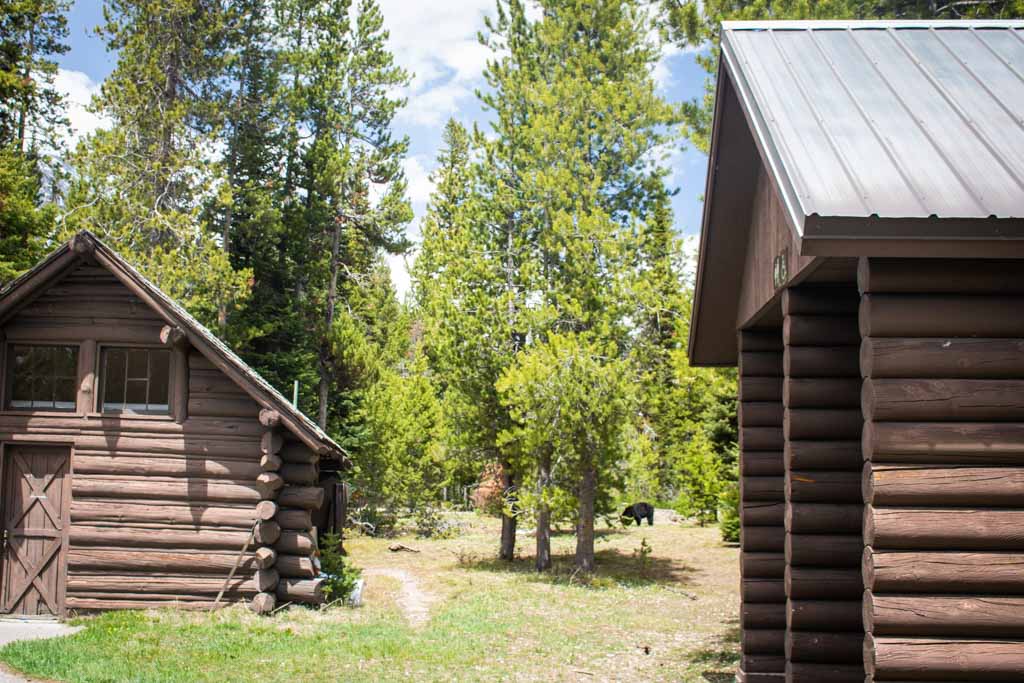
Jenny Lake
Even though it’s one of the most visited places in Grand Teton National Park, Jenny Lake is home to many animals, large and small. Bears are regular sights in this area, even on trails and in parking lots, and even if it’s really crowded.
The further away from the developed area around the popular Jenny Lake Visitor Center you go, the better your chances of seeing a black bear get.
Consider hiking the fantastic Jenny Lake Trail, which encircles the entire lake and offers opportunities for side hikes to Hidden Falls, Inspiration Point, and Cascade Canyon.
For a more casual Jenny Lake experience, with some potential bear sightings, you can walk the paved 0.35-mile Discovery Trail. A series of interpretive panels line the path, highlighting the area’s history, geology, and wildlife.
Another popular activity at Jenny Lake is taking a shuttle boat trip across the lake, which offers a unique perspective of this stunning landscape.
Teton Park Road (Between Jenny Lake and Signal Mountain)
One of the nicest scenic drives in the National Park System, the Teton Park Road connects Moose and Jackson Lake Junction. It parallels the base of the Teton Range, meandering its way for 20 miles past lakes and streams, and across sagebrush flats.
Wildlife abounds along the entire road, but, in my experience, the best section to see bears is between Jenny Lake and Signal Mountain.
You can park at roadside parking areas, such as the Cascade Canyon Turnout, Mountain View Turnout, and Mount Moran Turnout, and look for bears in the sagebrush or forest edges
Moose-Wilson Road
Connecting the towns of Moose (within the national park) and Wilson (outside the park), the Moose-Wilson Road is renowned for its abundant wildlife, including black bears.
The entire road is 15 miles long, with 7 miles inside Grand Teton National Park. Note that a 1.5-mile section of the road is unpaved. Additionally, trailers and RVs aren’t allowed on the Moose-Wilson Road.
Along the way, you’ll drive through a variety of habitats, primarily forests and marshes. Moose are commonly seen here, as are black bears and grizzly bears, especially in the fall.
Where to See Grizzly Bears in Grand Teton National Park
If you want to see grizzly bears in Grand Teton National Park, I recommend focusing on the northern and western areas in the park.
They’re particularly common along the shores of Jackson Lake and the pond-and-lake-dotted plains of the Willow Flats area, which includes Two Ocean and Emma Mathilda lakes.
You can also find grizzlies at higher elevations in the Tetons, especially the many canyons on the mountains’ east side. The middle section of the Teton Park Road, too, offers some excellent grizzly watching opportunities.
Willow Flats
Besides the Teton Park Road, Willow Flats may just be the best place to see grizzly bears in Grand Teton National Park.
Located just north of the Snake River and Jackson Lake Dam, the Willow Flats Overlook offers a sweeping view of these lowlands, while the majestic Teton Mountains tower in the distance.
Crossed by many small streams, dotted with willows, and covered with sagebrush, this is absolutely perfect grizzly habitat.
Both elk and moose thrive in this ecosystem and “rear their calves in the protection of the willow-shaded meadows,” the National Park Service says. Grizzly bears hunt these calves in spring and early-summer, while also foraging on bulbs and grubs.
The best times to see grizzlies at Willow Flats are dawn and dusk, but lucky visitors might even spot one in the middle of the afternoon.
Even though this is unquestionably one of the best grizzly viewing places in Grand Teton National Park, you’ll still need a bit of patience and some luck to see one. And if you don’t see a grizzly here, there are many other areas to visit and explore!
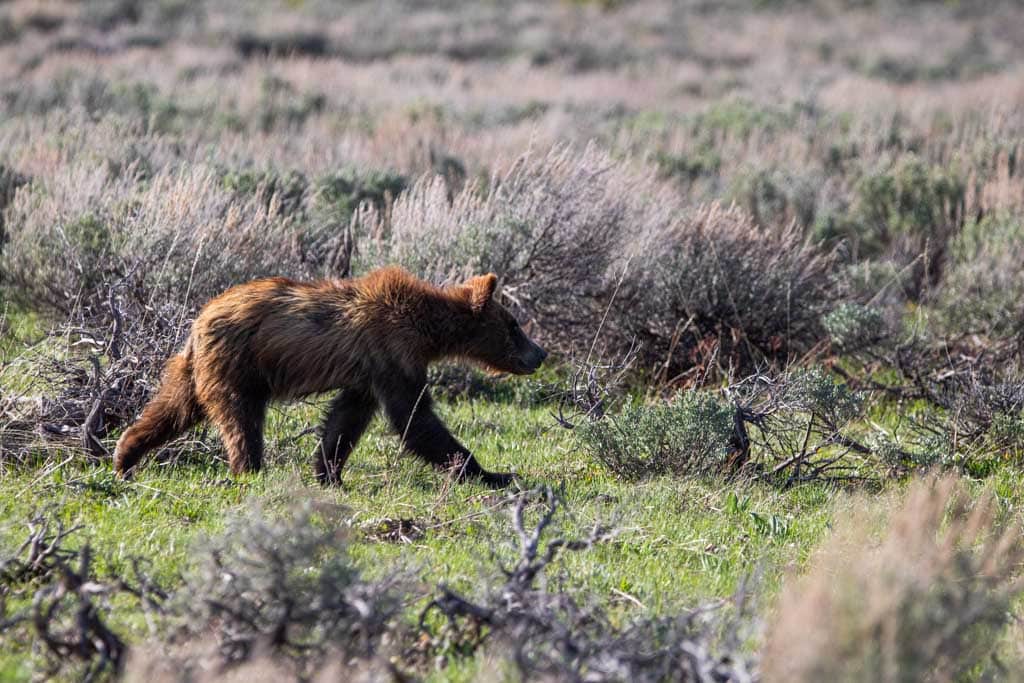
Two Ocean and Emma Mathilda Lakes
A variety of shrubs line the shores of Two Ocean and Emma Mathilda Lakes, while interspersed forests and meadows surround the lakes.
This is absolutely perfect grizzly habitat, making this one of the very best places to see grizzly bears in Grand Teton National Park.
As I’ve mentioned above in the black bear section, you have a few different options to explore this gorgeous area in the park’s northeast corner.
You can enjoy a wonderful view of Two Ocean Lake from the picnic area, which is also the starting point of the loop trail around the lake.
The trail around Emma Mathilda Lake can be reached from four different trailheads—the Two Ocean Lake Trailhead, a small trailhead on Pacific Creek Road, the Jackson Lake Lodge Trailhead, and the Grand View Point Trailhead.
Whatever trailhead and hike you choose, make sure you bring snacks and plenty of water, and don’t forget your bear spray!
- Two Ocean Lake Loop: 6.4 miles total, 3-4 hours
- Emma Mathilda Lake Loop: 10.7 miles total, 5-6 hours
- Two Ocean Lake – Emma Mathilda Lakes Loop: 13.2 total, 7-8 hours
Jenny Lake
Along with black bears, grizzly bears frequent the Jenny Lake area. Regardless of how busy the Jenny Lake tourist area is, there’s always a possibility of seeing or running into a bear here.
For your best chances of seeing a grizzly bear at Jenny Lake, I recommend visiting at dawn, which is by far the least crowded time of day. This will also ensure that you get a parking spot—the parking lot tends to fill up quickly during the high season.
Walk along the lakeshore on the Discovery Trail or hike a section of the Jenny Lake Trail.
I also highly recommend driving the beautiful Jenny Lake Scenic Drive (a few times) around sunrise for opportunities to see grizzlies.
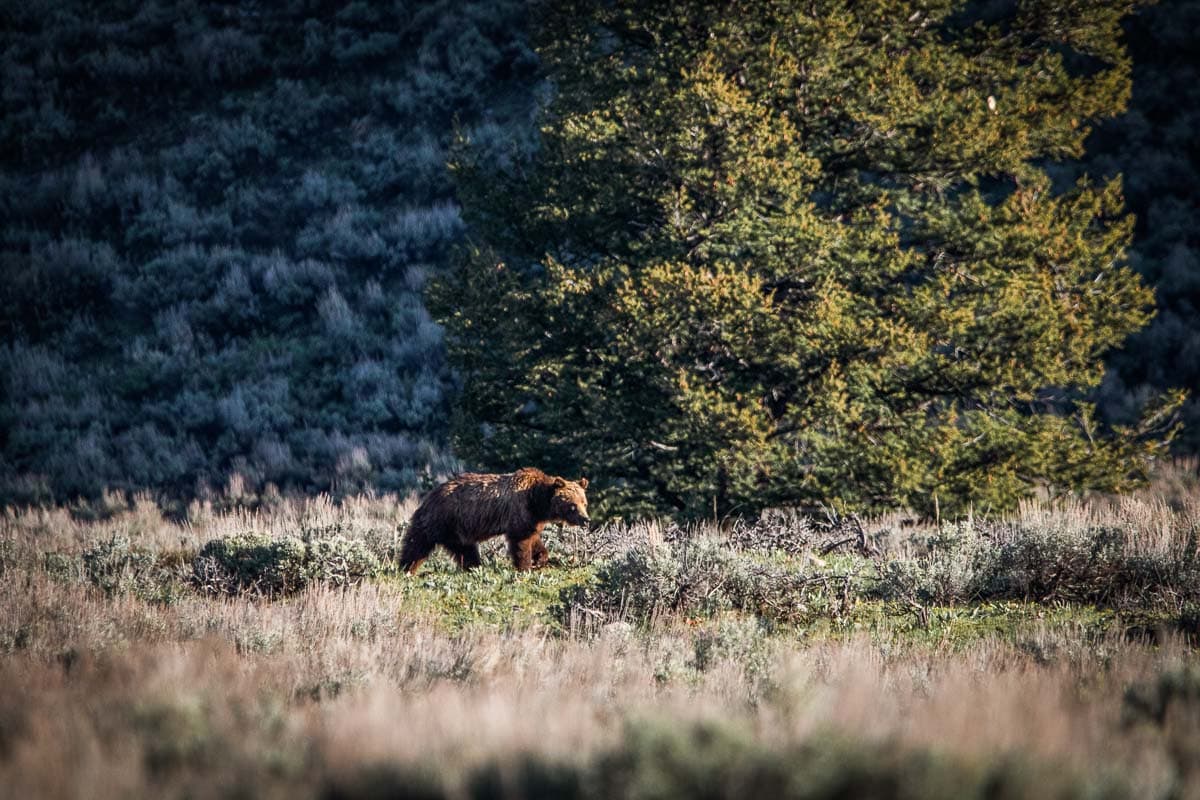
Cascade and Death Canyons
Several creeks have carved spectacular canyons in the east side of the Teton Range.
Among the most visited of them, relatively speaking, are Death Canyon and Cascade Canyon. Both of them make for a very long but superb day hike or overnight backpacking trip.
Cascade Canyon is directly above Jenny Lake and accessed via the Cascade Canyon Trail, which you can get to via the Jenny Lake Shuttle. This is a popular hiking destination that’s famous for its myriad wildlife, from tiny pikas and marmots to huge grizzly bears.
Death Canyon, on the other hand, is above Phelps Lake in the southwest of the park. The Death Canyon Trailhead is at the end of a spur road off the Moose-Wilson Road.
Note, however, that both these areas are extremely remote and have rocky terrain.
Trails are the only way in and out of these Teton Range canyons, so be prepared, plan your trip well, and let someone know where you’re going and when you’ll be back.
Of course, bear spray is absolutely essential on these hikes, too, as it is anywhere in Grand Teton National Park.
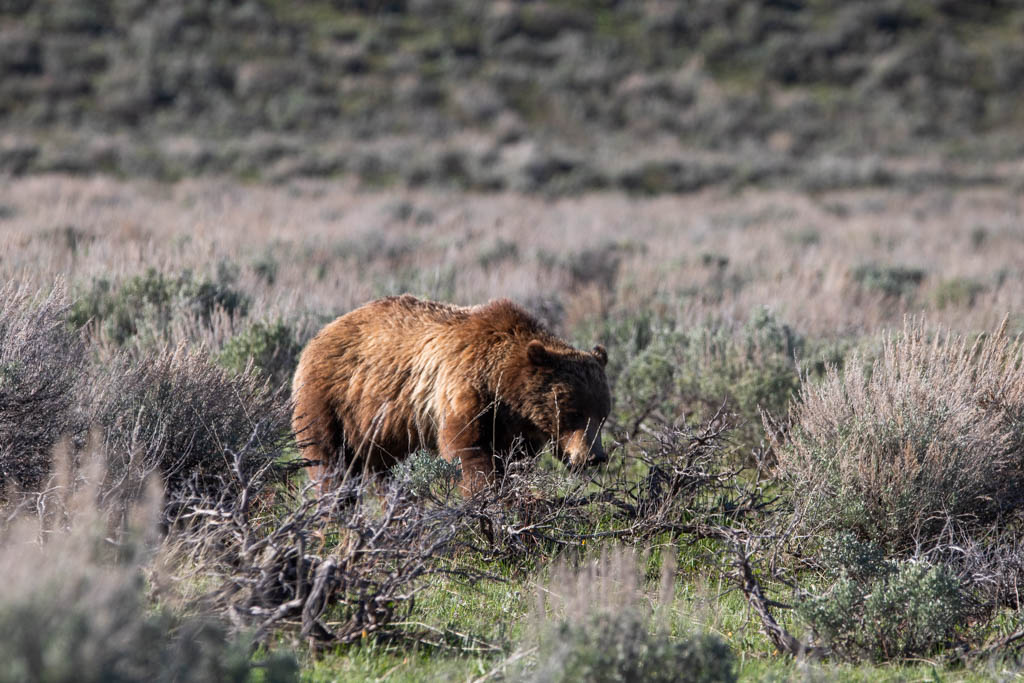
Teton Park Road (Between Jenny Lake and Signal Mountain)
Of all these places to see grizzly bears in Grand Teton National Park, I’ve personally been most fortunate on the Teton Park Road between Jenny Lake and Signal Mountain.
On that section of about 10 miles, I’ve seen several different grizzlies, including sows with cubs.
They seem to really like to openness of the sagebrush, combined with nearby woodlands for shelter, as well as easy access to a number of lakes, including Jenny Lake, Leigh Lake, and Jackson Lake.
Bears aren’t always around, though, but I do suggest spending a couple of hours just driving back and forth between Jenny Lake and Signal Mountain.
Roadside parking areas like the Cascade Canyon Turnout and Mountain View Turnout are excellent spots to just sit for a while and look for grizzlies.
They’re amazing places to have lunch or an afternoon snack, while enjoying a typical Grand Teton bear viewing experience. The views of the Teton Range are spectacular there, too.
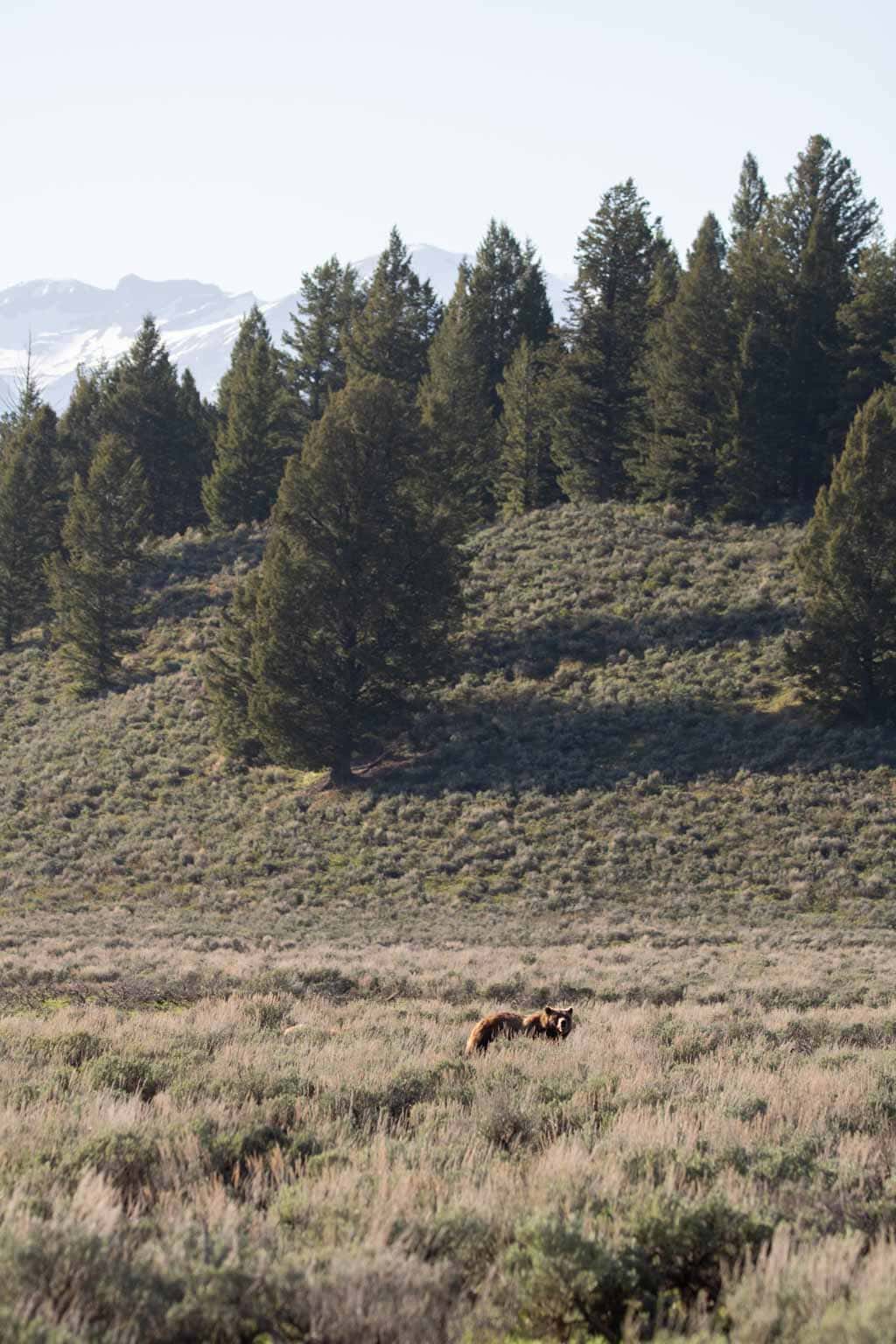
Moose-Wilson Road
The 7-mile section of the Moose-Wilson Road in Grand Teton National Park provides prime grizzly bear watching opportunities.
This stretch of road is in the remote southwest corner of the park, running past beautiful places like Phelps Lake and the Laurance S. Rockefeller Preserve. The trailheads of the Granite Canyon Trail and Death Canyon Trail are also along this road.
Take your time driving the Moose-Wilson Road—there could be wildlife around every turn, from elk, deer, and moose to black and grizzly bears.
Less visited than other places like Jenny Lake and Jackson Lake, this is easily one of the best areas to see bears in Grand Teton National Park.
Bear Safety in Yellowstone National Park
Black Bears
Neither Yellowstone nor Grand Teton National Park has ever had a confirmed fatality due to a black bear attack. However, as extremely rare as attacks by black bears are, they do occasionally occur.
It’s still very important to pay attention when recreating in Grand Teton National Park, though.
Black bears are common throughout the park and you may encounter one literally anywhere, even in parking lots, at trailheads, or right outside your accommodation or tent.
Learn what to do when encountering a black bear here.
Grizzly Bears
Grizzly bears in Grand Teton are a different story than black bears. This bear species is notoriously defensive and, as such, much more dangerous than their black cousins.
However, the chance of being injured, let alone killed, by a grizzly is still very, very small.
Incidents do occur, though, and they happen pretty much every year. According to the National Park Service, in adjacent Yellowstone National Park, “there have been 34 human injuries caused by grizzly bears in the backcountry, an average of one per year” since 1980.
In that same timespan, there have been only two grizzly-caused injuries to humans in developed areas in Yellowstone. That’s just one every 20 years.
Risk of Grizzly Attacks in Yellowstone National Park, by Location
- Developed areas, roadsides and boardwalks: 1 in 59.5 million visits
- Frontcountry campgrounds: 1 in 26.6 million overnight stays
- Backcountry campgrounds: 1 in 1.7 million overnight stays
- Backcountry trails: 1 in 232,613 person travel days
- All park activities combined: 1 in 2.7 million visits
These numbers clearly show how unlikely it is to be attacked by a grizzly in Yellowstone. And because Grand Teton has fewer bears and (relatively) less visitation than its famous neighbor, adverse human-grizzly encounters are even rarer in the park.
Yet, it’s still extremely important to be vigilant when visiting Grand Teton National Park, especially when recreating in the backcountry or at dawn/dusk.
You can encounter a grizzly bear anywhere in Grand Teton and, if that happens, you really do want to be prepared.
Learn what to do when encountering a grizzly bear here.
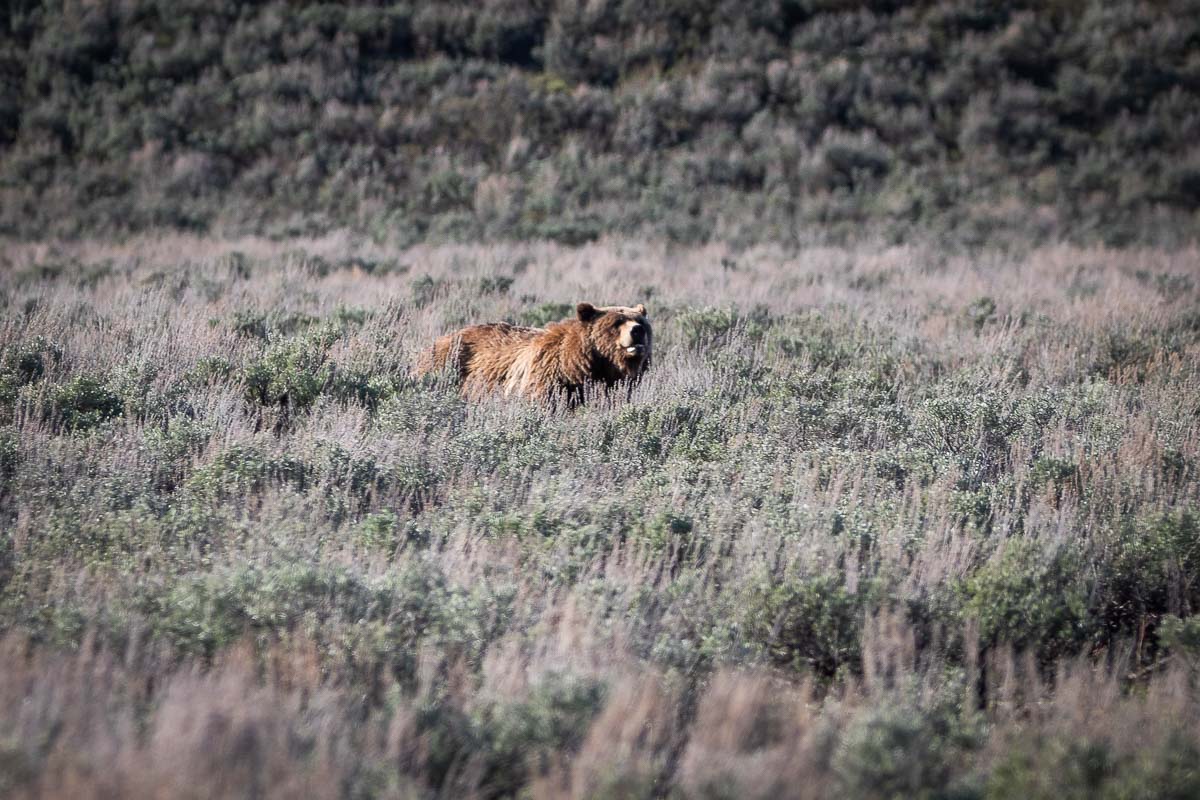
Bear Spray
By far the most effective way to protect yourself during a bear encounter, whether it’s a black bear or grizzly bear, is bear spray.
Learn how to use bear spray correctly here.
You can buy bear spray in numerous stores in and around Grand Teton National Park or online. (Remember that you cannot take bear spray on airplanes!)
More About Grand Teton National Park
- Park Website
- Travel Guide
- Topographic Map
- Best Grand Teton Hikes
- Top Things To Do in Grand Teton National Park
- Where to See Wildlife in Grand Teton National Park
- Best Views of the Tetons
- Names of Major Teton Range Peaks (With Photos)
- Accommodation
Map of the Best Places to See Bears in Grand Teton National Park
